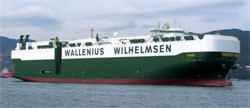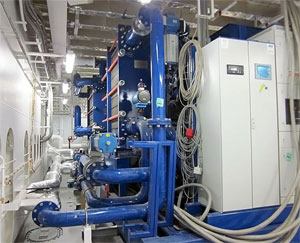There are currently around 16,000 registered vessels sailing worldwide. This huge commercial shipping fleet accounts for between 4 to 5 percent of the world’s carbon emissions suspected of causing climate change, according to Sweden’s Opcon Energy Systems AB.
One promising method for cutting carbon dioxide emissions — as well as nitrous oxides, sulfur dioxide and particulate matter — is to reduce fuel consumption by recovering low-value waste heat in a vessel’s steam and cooling systems. This waste heat can then be converted into electricity, replacing power that otherwise would have to be generated by the ship’s primary propulsion system. Reducing fuel usage also means lower operating costs.
 |
|
Courtesy Wallenius Marine |
|
Opcon’s equipment captures low-value waste heat from the ship’s propulsion system and converts it into electricity. |
The Opcon Powerbox technology permits the production of electricity from hot water or wet steam. Two versions of the Opcon Powerbox can be used for marine applications. These are the Opcon Powerbox ORC (Organic Rankine Cycle) and the Opcon Powerbox WST (Wet Steam Turbine). Over the past couple of years, Opcon is collaborating with Wallenius Marine to incorporate Opcon’s technology into one of its vessels, Figaro. The project is supported by the Swedish Energy Agency.
Figaro is a 747-foot large car truck carrier (LCTC) that can carry up to 7,879 cars. The ship is powered by a Doosan/MAN B&W 8S60-ME-C8 low-speed, supercharged, 19,040-kW (25,533-hp) diesel engine. The Opcon Powerbox technology is currently being tested aboard Figaro at sea. The Opcon Powerbox technology has been reviewed and found satisfactory by Lloyd’s Register.
The larger Opcon Powerbox ORC is supplied with heat recovered from the diesel engine’s cooling water and other sources such as the purge air cooler. The waste heat is used in heat exchangers to vaporize a working fluid that has a boiling point lower than water. This fluid allows the recovery of energy from low-grade waste heat sources. The resulting gas is expanded in an expander, or turbine, that drives a generator to produce electricity. The efficiency of the system is determined by the temperature difference between hot and cold media.
A key element in the Opcon Powerbox ORC is the expander or Lysholm turbine. This twin-screw turbine was developed by Opcon’s Svenska Rotor Maskiner (SRM). The Powerbox ORC can supply up to 500 kW of electricity in this application. The Powerbox ORC is already in use to turn waste heat to electric power in applications like the pulp and paper, wood and biofuel and other heavy industries.
The smaller Opcon Powerbox WST is powered by surplus steam available on the vessel such as compartment heating. It features a special type of steam turbine driving the generator that can use wet or saturated steam. This means it does not require steam heated above the boiling point where the steam is in equilibrium with heated water. This is in contrast to more conventional steam turbines where the steam is superheated.
This allows the use of low-value heat sources such as hot water in a vessel’s heating/cooling system without requiring major modifications.
Both of the Opcon Powerbox products can be incorporated in new vessels or retrofitted in existing ships. If incorporated in new designs, a smaller main propulsion system can be used to reduce both investment and operating costs.
For Figaro, the fuel savings are expected to reach 4 to 6 percent. While this may seem small, Wallenius’ vessels consume about 200,000 to 250,000 tons of bunker fuel annually. This amount of fuel savings means that carbon dioxide emissions are cut by about 37,000 tons a year and sulfur dioxide by some 150 tons annually. In the future, this technology could result in savings of up to 10 percent.
With ever higher oil prices and environmental requirements getting even tougher, Opcon expects this technology to become more commercially attractive. In some applications, the payback period could be as short as three years, the company said.

